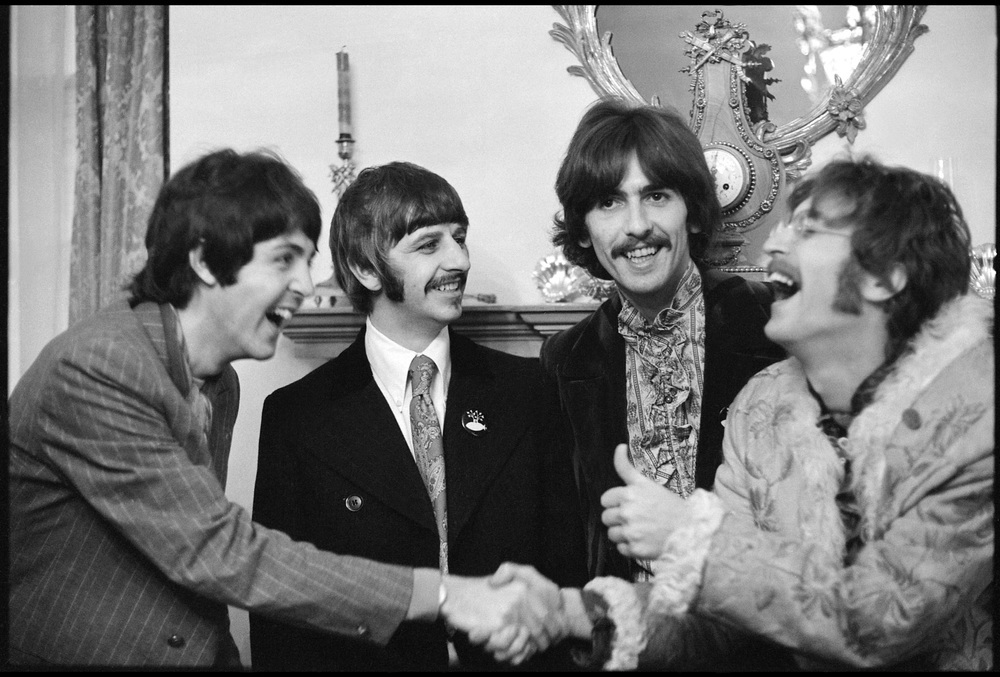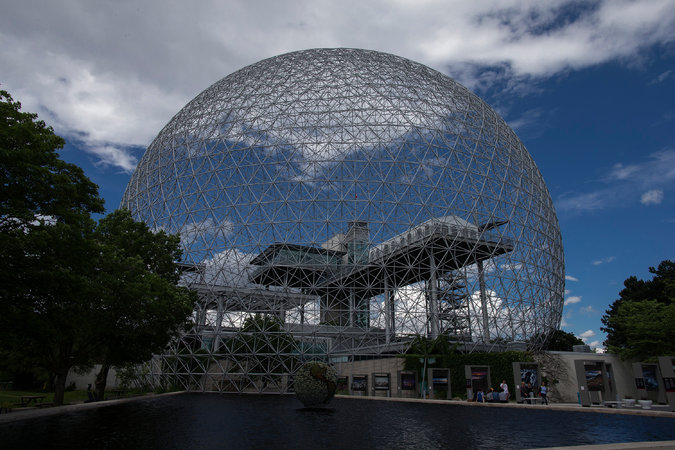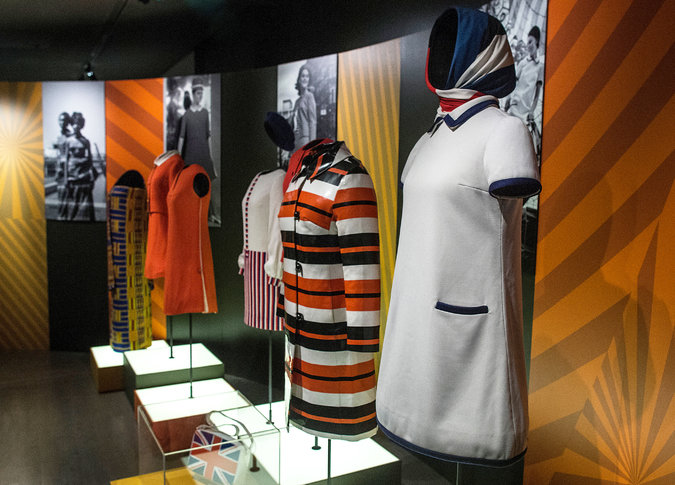NOT FADE AWAY: Montreal casts an eye on the 1960s and I revisit my youth
*You Say You Want a Revolution, Montreal Museum of Fine Arts to October 9
*In Search of Expo 67, Musée D’Art Contemporain de Montreal to October 9
*Fashioning Expo 67, McCord Museum to October 1
Plus an opinionated guide to eating and drinking in Canada’s cultural capital

The Beatles at Brian Epstein’s House by Linda McCartney, 1967. Photograph © MPL Communication. Reproduced with permission from Paul McCartney
Talleyrand once observed of the French Revolution that people who did not live before it would never know how sweet life is. It is the mission of You Say You Want a Revolution at the Montreal Museum of Fine Arts (organized with the Victoria and Albert in London) to breach the divide between those of us who lived through the 1960s and all those who came after (and are a bit tired of hearing that they missed something). The curators have done this well. When I visited on a weekday afternoon the galleries were filled with people of all ages tasting the sweetness by lying on beanbags and watching scenes from Woodstock on huge screens, dancing surreptitiously in a darkened room to Sly and the Family Stone, examining photos of the Black Panthers and stills from Blow Up, and encountering enough flotsam of the decade’s clothes, furniture, and food to answer the question, “what was it all about?”

Harry Willock, illustration for the Beatles’ “Revolution,” from The Beatles Illustrated Lyrics, 1969. © Harry Willock / Iconic Images
It was about a lot more than patchouli and funny lights, paper dresses and Sgt. Pepper, and although there was no revolution in the political sense despite sit-ins and riots, marches and demonstrations, the quality of public and personal life opened up radically after the stiff and sour 1950s. The exhibition conveys this convincingly, and its title, taken from John Lennon’s song, is well chosen. Lennon was always more “All You Need is Love” than Power to the People and so, for the most part, is the show. When you leave the galleries and walk out onto Sherbrooke Street the soft, sweet legacy of the 1960s is obvious in the public art by three contemporary artists who knew the decade well: Dale Chihuly’s carefully unruly Le Soleil (2003); Jim Dine’s hymn to communal happiness, Twin Hearts (1999), and the pop psychedelia of Pumpkin (2015) by Yayoi Kusama. But it is also there in the street antics of some McGill students I saw capering around outside their university. All unthinkable without that tumultuous decade.

Pedestrians walk past Pumpkin (2015), by Yayoi Kusama, as part of La Balade pour la Paix in Montreal on Monday June 5, 2017. Photo: Allen McInnis

Twin 6′ Hearts by Jim Dine, 1999. © Jim Dine / SODRAC (2015) – Photo: MBAM / MMFA, Denis Farley (2012)

Le Soleil by Dale Chihuly, 2013. 4,3 x 4,3 x 4,3 m. Montreal Museum of Fine Arts, courtesy Dale Chihuly. Photo: Hugo-Sébastien Aubert, Archives La Presse
In Search of Expo 67
If Revolution is the right brain of Montreal’s 1960s retrospective, In Search of Expo 67 at the Musee d’Art Contemporain is its left…to borrow from that mythological distinction between creativity and analytical reasoning.

Duane Linklater’s “Earth Mother Hair, Indian Hair, and Earth Mother Eyes, Indian Eyes, Animal Eyes” (2017) is part of “In Search of Expo 67” as one of numerous exhibitions celebrating the exposition’s 50th anniversary. Credit Sébastien Roy
Expo 67 was the last of the great world expositions and the first to predict that in the future everyone would be wired. What became of all that was promised during the heady spring, summer, and fall of 1967 is the subject of In Search of Expo 67: Nineteen artists all too young to have been at the fair consider the “global village” of sixty-two nations (and several corporations) and use every up-to-the-minute device of the digital world, including a drone, to reflect on its meaning fifty years later.
Montreal lives with the legacy of Expo 67; you can still see the American pavilion—Buckminster Filler’s geodesic dome (now an environmental science center)—from several spots along the river. And you can also get a good view of Moshe Safdie’s Habitat 67, a utopian reinvention of city-living in stacked cubes with terraces and gardens that lives on, though its mechanics have been altered and its inhabitants are much wealthier than the young Safdie had envisioned. What you cannot see is how thrilling these things were at the time, nor can you sense the giddy optimism of the fair when new technology was an exciting punctuation mark in the steady beat of the everyday. We are now inured to new technology; it is the everyday, and it brings with it not the whiff of utopianism but nothing much more than the inevitability of more new technology.

“Ensemble/Encore, Together/Again, Katimakainnarivugut” (2017), a multimedia installation by Geronimo Inutiq. Credit Sébastien Roy

The Biosphère, designed by Buckminster Fuller, housed the United States pavilion at Expo 67. It is now an environmental museum. Credit Alain Decarie for The New York Times
Fortunately, none of the nineteen artists at the MAC looks back at the fair with anything like regret at not having been there. They seem to know what the promise of a global village came to and they have moved on with their own reflections and inventions. I admired that, though some of the installations may be overthought and a few fail to communicate unless you consult all the verbiage accompanying them. Here is a sample description of one ambitious undertaking:
Jean-Pierre Aubé draws inspiration from Expo 67’s Kaleidoscope pavilion, which was sponsored by six Canadian chemical companies. The pavilion was designed by Morley Markson, who created a dynamic psychedelic experience of colour and experimental music as visitors walked through three film projections refracted by multiple mirrors. Aubé’s installation consists of short videos that show the time-lapse crystallization of chemicals purchased through the deep web. Adopting a scientific method, Aubé modified a microscope and used polarized lighting to reveal colour within the crystals, making their internal structures and materiality visible. Each of the short videos is then analyzed in real time using a facial recognition algorithm and relayed to a network of analogue synthesizers. The original soundtrack for Kaleidoscope was by Canadian composer R. Murray Schafer, known for having coined the term “soundscape”; Aubé, for this work, has modified a track from Voïvod’s Killing Technology album of 1987, referencing the dystopian avant-garde music of thrash metal.

A still from Cheryl Sim’s video “Un Jour, Un Jour” (2017). Credit Cheryl Sim
Well, better that by far than something like a wan re-creation of the glorious Czech pavilion with its wonderful display of several centuries of ceramics, glass, and textiles, its liberal pourings of Pilsner Urquell, its stylish puppet shows for children, and its big draw: the Kino-Automat’s immersive forty-five-minute film where the audience pushed buttons next to their seats to vote five times on what should happen in the plot, and a computer tallied the results on the screen. You had to be there, and if you weren’t, let it go and move forward, which is what the MAC and its artists have done.
(For a less challenging view of Expo 67, visit the McCord Museum’s display of its sleek fashions.)

The McCord Museum is presenting “Fashioning Expo 67,” featuring various uniforms worn by hostesses during the 1967 event. Credit Alain Decarie for The New York Times
DAVID INFANTE: FOOD AND DRINK IN MONTREAL
You can trust David Infante who writes for Thrillist and has won two James Beard awards to come up with a range of enticing places to eat and drink.
Places I can personally vouch for
Beauty’s Luncheonette: a classic retro diner with substantial breakfasts
Fairmount Bagel: supposedly the first bagel place in Montreal and as good a place as any to get a Montreal bagel
St. Viateur Bagel: the other all-time classic purveyor of Montreal-style bagels, less old but just as exemplary
La Banquise: the go-to place for poutine
Schwartz’s: the first and last word on Montreal’s smoked meat tradition
Places I’ve never been to recommended to me by Zach Mack, owner of ABC Beer Co. and a trustworthy source
L’Academie for a really good BYOB dinner
Joe Beef is a truly incredible dining experience. Quirky, hip, borderline irreverent…I really suggest you go. The owner is a badass!
Pullman for wine! Anthony Bourdain loves it.
Bistro L’Express will make you feel as though you have been magically transported to Paris: The duck confit! The wine list!
Queue de Cheval is the best steakhouse in the city, period.
Big In Japan for good late night eats right in the thick of it all…
…Big In Japan Bar is even better. And it’s a secret!
Au Pied de Cochon is definitely the most celebrated restaurant in Montreal, maybe the most in Canada.
Bar Saint Sulpice is a MASSIVE open air bar in the middle of Rue Saint Denis, which is the francophone Montrealer’s broadway.
Else’s is a simple, unassuming bar with awesome food and a truly Montreal vibe that I miss pretty much every day.
Notre Dame des Quilles is a bar I discovered on my last visit up there. It is in the super hip Little Italy neighborhood and it is itself super hip!
You can learn more about David or follow him on Twitter, Instagram or Facebook.

